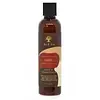What's inside
What's inside
 Key Ingredients
Key Ingredients

 Benefits
Benefits

 Concerns
Concerns

 Ingredients Side-by-side
Ingredients Side-by-side

Water
Skin ConditioningRosa Centifolia Flower Extract
AstringentEuterpe Oleracea Fruit Extract
Zingiber Officinale Root Extract
MaskingLavandula Angustifolia Flower Extract
CleansingCalendula Officinalis Flower Extract
MaskingSclerocarya Birrea Seed Oil
HumectantTheobroma Cacao Seed Butter
EmollientButyrospermum Parkii Butter
Skin ConditioningArgania Spinosa Kernel Oil
EmollientPrunus Amygdalus Dulcis Oil
Skin ConditioningRicinus Communis Seed Oil
MaskingHelianthus Annuus Seed Oil
EmollientTheobroma Grandiflorum Seed Butter
Skin ConditioningHoney
HumectantHypericum Perforatum Flower Extract
Skin ConditioningTocopheryl Acetate
AntioxidantPanthenol
Skin ConditioningPropanediol
SolventCetearyl Alcohol
EmollientCetyl Alcohol
EmollientPhenoxyethanol
PreservativeCaprylyl Glycol
EmollientDisodium EDTA
Rosmarinus Officinalis Leaf Extract
AntimicrobialParfum
MaskingWater, Rosa Centifolia Flower Extract, Euterpe Oleracea Fruit Extract, Zingiber Officinale Root Extract, Lavandula Angustifolia Flower Extract, Calendula Officinalis Flower Extract, Sclerocarya Birrea Seed Oil, Theobroma Cacao Seed Butter, Butyrospermum Parkii Butter, Argania Spinosa Kernel Oil, Prunus Amygdalus Dulcis Oil, Ricinus Communis Seed Oil, Helianthus Annuus Seed Oil, Theobroma Grandiflorum Seed Butter, Honey, Hypericum Perforatum Flower Extract, Tocopheryl Acetate, Panthenol, Propanediol, Cetearyl Alcohol, Cetyl Alcohol, Phenoxyethanol, Caprylyl Glycol, Disodium EDTA, Rosmarinus Officinalis Leaf Extract, Parfum
Water
Skin ConditioningCetearyl Alcohol
EmollientCetyl Alcohol
EmollientCocos Nucifera Fruit Extract
EmollientPhyllanthus Emblica Fruit Extract
HumectantBeta Vulgaris Root Extract
Skin ConditioningPhytosterols
Skin ConditioningSerenoa Serrulata Fruit Extract
Skin ConditioningCamellia Sinensis Leaf Extract
AntimicrobialGlycerin
HumectantPyrus Malus Fruit Extract
Skin ConditioningCitrus Limon Peel Extract
EmollientSaccharum Officinarum Extract
MoisturisingBetaine
HumectantBehentrimonium Methosulfate
Stearamidopropyl Dimethylamine
EmulsifyingCitric Acid
BufferingPhenoxyethanol
PreservativeCaprylyl Glycol
EmollientPotassium Sorbate
PreservativePolyacrylamide
Parfum
MaskingAnise Alcohol
PerfumingCoumarin
PerfumingLimonene
PerfumingWater, Cetearyl Alcohol, Cetyl Alcohol, Cocos Nucifera Fruit Extract, Phyllanthus Emblica Fruit Extract, Beta Vulgaris Root Extract, Phytosterols, Serenoa Serrulata Fruit Extract, Camellia Sinensis Leaf Extract, Glycerin, Pyrus Malus Fruit Extract, Citrus Limon Peel Extract, Saccharum Officinarum Extract, Betaine, Behentrimonium Methosulfate, Stearamidopropyl Dimethylamine, Citric Acid, Phenoxyethanol, Caprylyl Glycol, Potassium Sorbate, Polyacrylamide, Parfum, Anise Alcohol, Coumarin, Limonene
 Reviews
Reviews

Ingredients Explained
These ingredients are found in both products.
Ingredients higher up in an ingredient list are typically present in a larger amount.
Caprylyl Glycol is a humectant and emollient, meaning it attracts and preserves moisture.
It is a common ingredient in many products, especially those designed to hydrate skin. The primary benefits are retaining moisture, skin softening, and promoting a healthy skin barrier.
Though Caprylyl Glycol is an alcohol derived from fatty acids, it is not the kind that can dry out skin.
This ingredient is also used as a preservative to extend the life of products. It has slight antimicrobial properties.
Learn more about Caprylyl GlycolCetearyl alcohol is a mixture of two fatty alcohols: cetyl alcohol and stearyl alcohol. It is mainly used as an emulsifier. Emulsifiers help prevent the separation of oils and products. Due to its composition, it can also be used to thicken a product or help create foam.
Cetearyl alcohol is an emollient. Emollients help soothe and hydrate the skin by trapping moisture.
Studies show Cetearyl alcohol is non-toxic and non-irritating. The FDA allows products labeled "alcohol-free" to have fatty alcohols.
This ingredient is usually derived from plant oils such as palm, vegetable, or coconut oils. There is debate on whether this ingredient will cause acne.
Due to the fatty acid base, this ingredient may not be Malassezia folliculitis safe.
Learn more about Cetearyl AlcoholCetyl Alcohol is a fatty alcohol. Fatty Alcohols are most often used as an emollient or to thicken a product.
Its main roles are:
Though it has "alcohol" in the name, it is not related to denatured alcohol or ethyl alcohol.
The FDA allows products labeled "alcohol-free" to have fatty alcohols.
Learn more about Cetyl AlcoholParfum is a catch-all term for an ingredient or more that is used to give a scent to products.
Also called "fragrance", this ingredient can be a blend of hundreds of chemicals or plant oils. This means every product with "fragrance" or "parfum" in the ingredients list is a different mixture.
For instance, Habanolide is a proprietary trade name for a specific aroma chemical. When used as a fragrance ingredient in cosmetics, most aroma chemicals fall under the broad labeling category of “FRAGRANCE” or “PARFUM” according to EU and US regulations.
The term 'parfum' or 'fragrance' is not regulated in many countries. In many cases, it is up to the brand to define this term.
For instance, many brands choose to label themselves as "fragrance-free" because they are not using synthetic fragrances. However, their products may still contain ingredients such as essential oils that are considered a fragrance by INCI standards.
One example is Calendula flower extract. Calendula is an essential oil that still imparts a scent or 'fragrance'.
Depending on the blend, the ingredients in the mixture can cause allergies and sensitivities on the skin. Some ingredients that are known EU allergens include linalool and citronellol.
Parfum can also be used to mask or cover an unpleasant scent.
The bottom line is: not all fragrances/parfum/ingredients are created equally. If you are worried about fragrances, we recommend taking a closer look at an ingredient. And of course, we always recommend speaking with a professional.
Learn more about ParfumPhenoxyethanol is a preservative that has germicide, antimicrobial, and aromatic properties. Studies show that phenoxyethanol can prevent microbial growth. By itself, it has a scent that is similar to that of a rose.
It's often used in formulations along with Caprylyl Glycol to preserve the shelf life of products.
Water. It's the most common cosmetic ingredient of all. You'll usually see it at the top of ingredient lists, meaning that it makes up the largest part of the product.
So why is it so popular? Water most often acts as a solvent - this means that it helps dissolve other ingredients into the formulation.
You'll also recognize water as that liquid we all need to stay alive. If you see this, drink a glass of water. Stay hydrated!
Learn more about Water